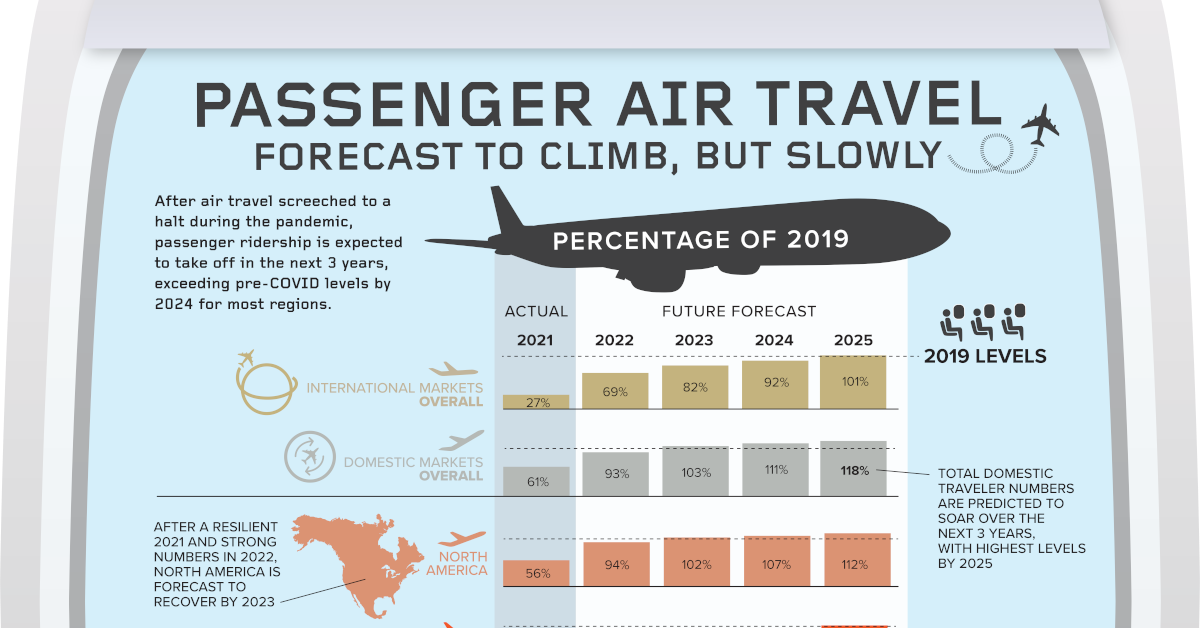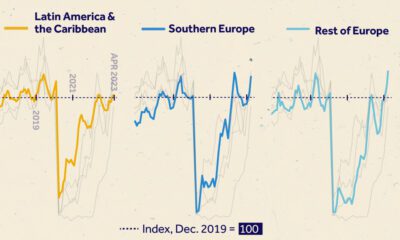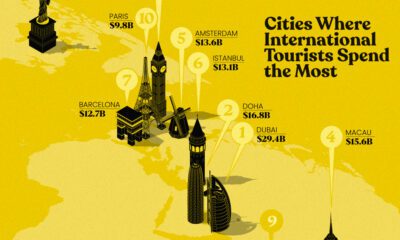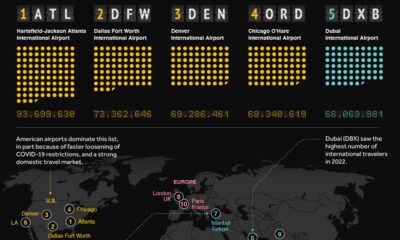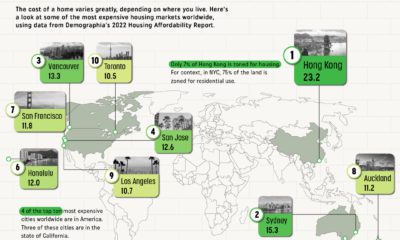Markets
When Will Air Travel Return to Pre-Pandemic Levels?
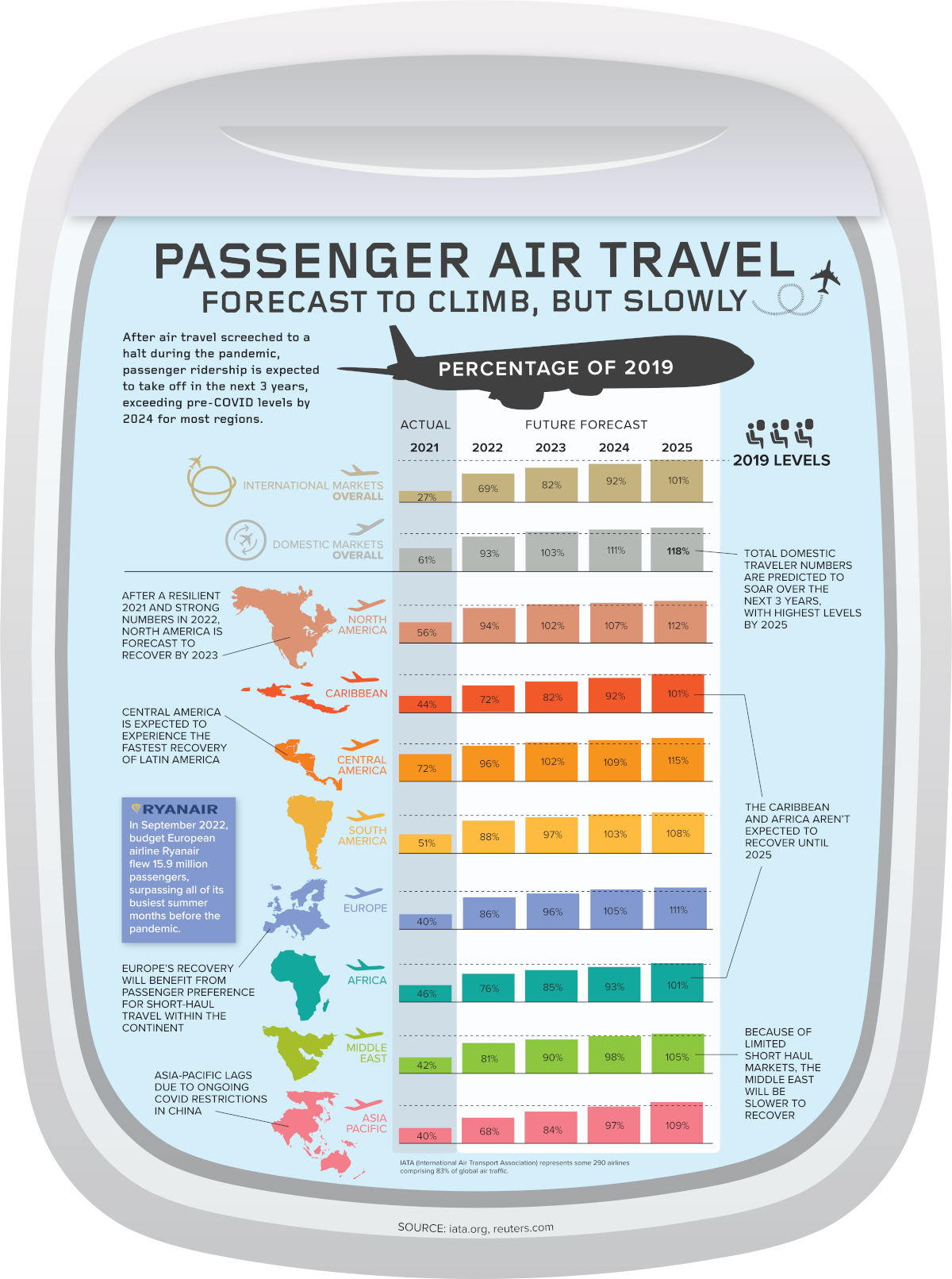
When Will Air Travel Return to Pre-Pandemic Levels?
Many industries were hit hard by the global pandemic, but it can be argued that air travel suffered one of the most severe blows.
The aviation industry as a whole suffered an estimated $370 billion loss in global revenue because of COVID-19. And while air travel has been slowly recovering from the trough, flight passenger traffic has yet to fully bounce back.
Where is the industry at in 2022 compared to pre-COVID times, and when is air passenger travel expected to return to regular levels? This graphic by Julie R. Peasley uses data from IATA to show current and projected air passenger ridership.
Air Travel Traffic: 2021 and 2022
After an incredibly difficult 2020, the airline industry started to see significant improvements in travel frequency. But compared to pre-pandemic levels, there’s a lot of ground to cover.
In 2021, overall passenger numbers only reached 47% of 2019 levels. This influx was largely driven by domestic travel, with international passenger numbers only reaching 27% of pre-COVID levels.
| Passenger numbers (% of 2019) | 2021 | 2022 |
|---|---|---|
| International | 27% | 69% |
| Domestic | 61% | 93% |
| Africa | 46% | 76% |
| Asia Pacific | 40% | 68% |
| Caribbean | 44% | 72% |
| Central America | 72% | 96% |
| Europe | 40% | 86% |
| Middle East | 42% | 81% |
| North America | 56% | 94% |
| South America | 51% | 88% |
| Industry-wide | 47% | 83% |
From a regional perspective, Central America experienced one of the fastest recoveries. In 2021, overall passenger numbers in the region had reached 72% of 2019 levels, and they are projected to reach 96% by the end of 2022.
In fact, the Americas as a whole has seen a quick recovery. Both North America and South America also reached above 50% of 2019 ridership in 2021, and are projected to reach 94% and 88% ridership in 2022, respectively.
On the opposite end of the spectrum, Asia Pacific has experienced the slowest recovery. This is likely due to stricter lockdowns and travel restrictions put into effect in this region (which was harder hit by SARS in 2003), especially in places like Shanghai.
Forecasting Traffic in 2023 and Beyond
While recovery has looked different from region to region, airlines are largely expected to see a full recovery to their ridership levels by 2025.
| Forecasted Passengers (% of 2019) | 2023 | 2024 | 2025 |
|---|---|---|---|
| International | 82% | 92% | 101% |
| Domestic | 103% | 111% | 118% |
| Africa | 85% | 93% | 101% |
| Asia Pacific | 84% | 97% | 109% |
| Caribbean | 82% | 92% | 101% |
| Central America | 102% | 109% | 115% |
| Europe | 96% | 105% | 111% |
| Middle East | 90% | 98% | 105% |
| North America | 102% | 107% | 112% |
| South America | 97% | 103% | 108% |
| Industry-wide | 94% | 103% | 111% |
This recovery is a signifier of a much broader mindset shift, as governments continue to reassess their COVID-19 management strategies.
But while the future seems promising, IATA stressed that the forecast does not take into account the potential impact of the Russia-Ukraine conflict and other geopolitical concerns, which could have far-reaching consequences on the global economy (and travel) in the coming years.

This article was published as a part of Visual Capitalist's Creator Program, which features data-driven visuals from some of our favorite Creators around the world.
Economy
Economic Growth Forecasts for G7 and BRICS Countries in 2024
The IMF has released its economic growth forecasts for 2024. How do the G7 and BRICS countries compare?

G7 & BRICS Real GDP Growth Forecasts for 2024
The International Monetary Fund’s (IMF) has released its real gross domestic product (GDP) growth forecasts for 2024, and while global growth is projected to stay steady at 3.2%, various major nations are seeing declining forecasts.
This chart visualizes the 2024 real GDP growth forecasts using data from the IMF’s 2024 World Economic Outlook for G7 and BRICS member nations along with Saudi Arabia, which is still considering an invitation to join the bloc.
Get the Key Insights of the IMF’s World Economic Outlook
Want a visual breakdown of the insights from the IMF’s 2024 World Economic Outlook report?
This visual is part of a special dispatch of the key takeaways exclusively for VC+ members.
Get the full dispatch of charts by signing up to VC+.
Mixed Economic Growth Prospects for Major Nations in 2024
Economic growth projections by the IMF for major nations are mixed, with the majority of G7 and BRICS countries forecasted to have slower growth in 2024 compared to 2023.
Only three BRICS-invited or member countries, Saudi Arabia, the UAE, and South Africa, have higher projected real GDP growth rates in 2024 than last year.
| Group | Country | Real GDP Growth (2023) | Real GDP Growth (2024P) |
|---|---|---|---|
| G7 | 🇺🇸 U.S. | 2.5% | 2.7% |
| G7 | 🇨🇦 Canada | 1.1% | 1.2% |
| G7 | 🇯🇵 Japan | 1.9% | 0.9% |
| G7 | 🇫🇷 France | 0.9% | 0.7% |
| G7 | 🇮🇹 Italy | 0.9% | 0.7% |
| G7 | 🇬🇧 UK | 0.1% | 0.5% |
| G7 | 🇩🇪 Germany | -0.3% | 0.2% |
| BRICS | 🇮🇳 India | 7.8% | 6.8% |
| BRICS | 🇨🇳 China | 5.2% | 4.6% |
| BRICS | 🇦🇪 UAE | 3.4% | 3.5% |
| BRICS | 🇮🇷 Iran | 4.7% | 3.3% |
| BRICS | 🇷🇺 Russia | 3.6% | 3.2% |
| BRICS | 🇪🇬 Egypt | 3.8% | 3.0% |
| BRICS-invited | 🇸🇦 Saudi Arabia | -0.8% | 2.6% |
| BRICS | 🇧🇷 Brazil | 2.9% | 2.2% |
| BRICS | 🇿🇦 South Africa | 0.6% | 0.9% |
| BRICS | 🇪🇹 Ethiopia | 7.2% | 6.2% |
| 🌍 World | 3.2% | 3.2% |
China and India are forecasted to maintain relatively high growth rates in 2024 at 4.6% and 6.8% respectively, but compared to the previous year, China is growing 0.6 percentage points slower while India is an entire percentage point slower.
On the other hand, four G7 nations are set to grow faster than last year, which includes Germany making its comeback from its negative real GDP growth of -0.3% in 2023.
Faster Growth for BRICS than G7 Nations
Despite mostly lower growth forecasts in 2024 compared to 2023, BRICS nations still have a significantly higher average growth forecast at 3.6% compared to the G7 average of 1%.
While the G7 countries’ combined GDP is around $15 trillion greater than the BRICS nations, with continued higher growth rates and the potential to add more members, BRICS looks likely to overtake the G7 in economic size within two decades.
BRICS Expansion Stutters Before October 2024 Summit
BRICS’ recent expansion has stuttered slightly, as Argentina’s newly-elected president Javier Milei declined its invitation and Saudi Arabia clarified that the country is still considering its invitation and has not joined BRICS yet.
Even with these initial growing pains, South Africa’s Foreign Minister Naledi Pandor told reporters in February that 34 different countries have submitted applications to join the growing BRICS bloc.
Any changes to the group are likely to be announced leading up to or at the 2024 BRICS summit which takes place October 22-24 in Kazan, Russia.
Get the Full Analysis of the IMF’s Outlook on VC+
This visual is part of an exclusive special dispatch for VC+ members which breaks down the key takeaways from the IMF’s 2024 World Economic Outlook.
For the full set of charts and analysis, sign up for VC+.
-

 Education1 week ago
Education1 week agoHow Hard Is It to Get Into an Ivy League School?
-

 Technology2 weeks ago
Technology2 weeks agoRanked: Semiconductor Companies by Industry Revenue Share
-

 Markets2 weeks ago
Markets2 weeks agoRanked: The World’s Top Flight Routes, by Revenue
-

 Demographics2 weeks ago
Demographics2 weeks agoPopulation Projections: The World’s 6 Largest Countries in 2075
-

 Markets2 weeks ago
Markets2 weeks agoThe Top 10 States by Real GDP Growth in 2023
-

 Demographics2 weeks ago
Demographics2 weeks agoThe Smallest Gender Wage Gaps in OECD Countries
-

 Economy2 weeks ago
Economy2 weeks agoWhere U.S. Inflation Hit the Hardest in March 2024
-

 Green2 weeks ago
Green2 weeks agoTop Countries By Forest Growth Since 2001
